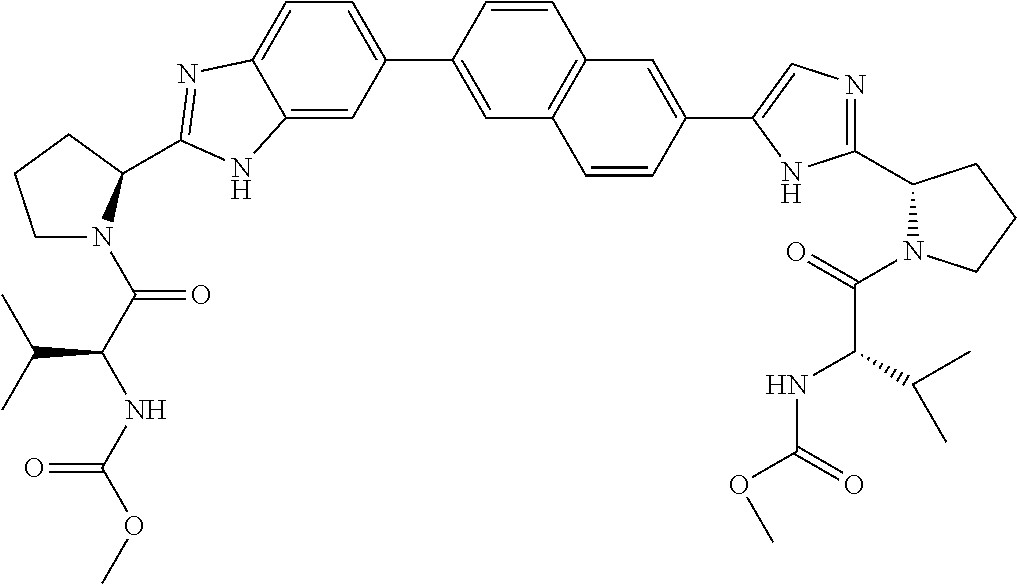Benzimidazole-imidazole derivatives
a technology of benzimidazole and derivatives, applied in the field of benzimidazole-imidazole derivatives, can solve the problems of high rate of chronic infection, increased risk of cardiovascular disease, and increased risk of cardiovascular disease, and achieves the effects of neuropsychiatric symptoms, neuropsychiatric symptoms, and hematologic abnormalities
- Summary
- Abstract
- Description
- Claims
- Application Information
AI Technical Summary
Benefits of technology
Problems solved by technology
Method used
Image
Examples
example 1
Synthesis of Compounds of Formula XVIIIa
[0192]
1.1 Preparation of Intermediate IIa (PG=Boc; X=Bra
[0193]
[0194]To a solution of Boc-L-Proline (2669 mg, 12.4 mmol) in pyridine / DMF (30 mL, 1 / 1) was added di(1H-imidazol-1-yl)ketone (2205 mg, 13.6 mmol). The mixture was stirred at 45° C. for 2 hours. 4-bromobenzene-1,2-diamine (2319 mg, 12.4 mmol) was added and the mixture was stirred at ambient temperature overnight. The solvent was removed and the residue heated in acetic acid (15 mL) at 100° C. for 30 minutes. After concentration of the residue, the mixture was partitioned between ethyl acetate and a saturated sodium bicarbonate solution. The organic phase was separated and washed with water, after drying over Na2SO4, the mixture was filtrated and the filtrate was concentrated in vacuum. The obtained residue was purified by flash chromatography using CH2Cl2 / EtOAc 90 / 10 to 50 / 50, resulting in compound IIa (3.146 g, 69%).
1.1a Preparation of Intermediate IIb (PG=Cbz; X=Br)
[0195]
[0196]To a ...
example 2
Synthesis of Compounds of Formula XVIIIb
[0210]
2.1 preparation of L-boc-prolinol
[0211]Borane-methyl sulfide complex (180 mL, 1.80 mol) was added dropwise to a solution of N-Boc-L-Proline (300 g, 1.39 mol) in anhydrous THF (3.0 L) which was cooled to 0° C. When gas evolution ceased, the ice bath was removed and the solution was stirred at 10° C. for 18 hours. Thin layer chromatography (TLC) showed that no starting material remained and that the desired product was formed. The solution was cooled to 0° C. and methanol (2.4 L) was slowly added. The solvents were removed under reduced pressure. The residue was reconstituted in dichloromethane (1 L), washed with NaHCO3 (500 mL, saturated, aqueous) and brine (500 mL), dried over MgSO4, the solids were removed via filtration, and the solvents of the filtrate were removed under reduced pressure to afford a white solid, 260 g (93%), used in the next step without further purification.
2.2 preparation of L-boc-prolinal
[0212]To a solution of L-bo...
example 2a
Synthesis of Compounds of Formula XXVI and XXVII
[0261]
2a.1 Preparation of Intermediate XXVb
[0262]
[0263]To IXb (2.63 g, 5.37 mmol), IIb (2.80 g, 6.99 mmol), PdCl2(dppf) (298 mg, 0.537 mmol) and sodiumbicarbonate (1.354 g, 16.12 mmol), dioxane / water (50 mL, 5 / 1) was added. The reaction was heated for 13 hours at 80° C. under argon atmosphere. The reaction mixture was cooled to room temperature, diluted with dichloromethane and brine was added, the mixture was filtrated over decalite and the organic phase separated. The organic phase was dried with MgSO4, the solvent was removed under reduced pressure and purified by column chromatography (gradient from 0 to 3% methanol in CH2Cl2) to yield XXVb (2.086 g, 57%)
2a.2 Preparation of Intermediate XXVc
[0264]
[0265]A stirring solution of VIIIc (36.1 g, 75.8 mmol), Ma (28.5 g, 68.89 mmol) and sodiumbicarbonate (17.36 g, 206.7 mmol) in dioxane / water (500 mL, 5 / 1) was flushed with nitrogen for 10 minutes before addition of PdCl2(dppf) (5.04 g, 6.8...
PUM
| Property | Measurement | Unit |
|---|---|---|
| temperature | aaaaa | aaaaa |
| temperature | aaaaa | aaaaa |
| temperature | aaaaa | aaaaa |
Abstract
Description
Claims
Application Information
 Login to View More
Login to View More - R&D
- Intellectual Property
- Life Sciences
- Materials
- Tech Scout
- Unparalleled Data Quality
- Higher Quality Content
- 60% Fewer Hallucinations
Browse by: Latest US Patents, China's latest patents, Technical Efficacy Thesaurus, Application Domain, Technology Topic, Popular Technical Reports.
© 2025 PatSnap. All rights reserved.Legal|Privacy policy|Modern Slavery Act Transparency Statement|Sitemap|About US| Contact US: help@patsnap.com



